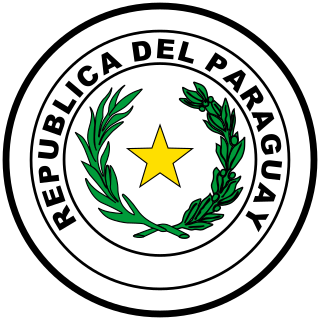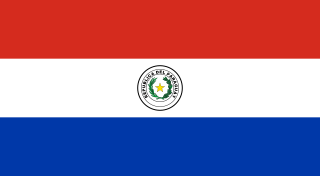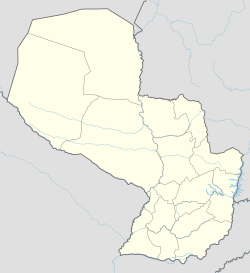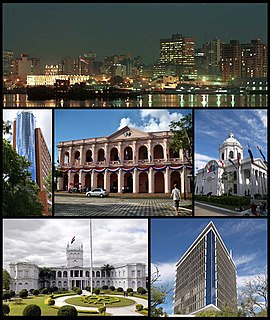
A Jesuit reduction was a type of settlement for indigenous people in North and South America established by the Jesuit Order from the 16th to the 18th centuries. The Spanish and Portuguese Empires adopted a strategy of gathering native populations into communities called "Indian reductions" and Portuguese: "redução". The objectives of the reductions were to organize and exploit the labor of the native indigenous inhabitants while also imparting Christianity and European culture. Secular as well as religious authorities created reductions.

Concepción is a department of Paraguay. The capital is the city of Concepción.

Caazapá is a city in Paraguay, founded in 1607, by Friar Luis de Bolaños. It is located in the Caazapá District and is the capital of the Caazapá Department. The name Caazapá comes from the Guarani words "Ka'aguy jehasapa" which means "after the forest", because the natives believed that after the forest, God, with the attendance of Friar Luis de Bolaños, has made born water from the Earth. There are five neighbourhoods called "Barrios" in the city: Then main one is the Barrio San Pablo, the other 4 are: Barrio Santa Teresita, Barrio San Blás, Barrio San Antonio, and Barrio San Roque-within which is the original Chapel, built by franciscans during the famous Jesuit reductions of Paraguay. The Franciscan Reduction at Caazapá was an important event in Paraguayan cultural heritage.

Yaguarón is a city in Paraguay, located at the base of Yaguarón Hill in the Yaguarón District of Paraguarí Department, 48 kilometres (30 mi) from the capital Asunción. The town began as a Franciscan reservation for the Guaraní Indians.

Villa Hayes is a city in Paraguay, and is the capital of Presidente Hayes Department.

Misión de Nuestra Señora de Loreto Conchó, or Mission Loreto, was founded on October 25, 1697 at the Monqui Native American (Indian) settlement of Conchó in the present city of Loreto, Baja California Sur, Mexico. Established by the Catholic Church's Jesuit missionary Juan María de Salvatierra, Loreto was the first successful mission and Spanish town in Baja California. The mission is located at 26°00′37″N111°20′36″W.

The Baroque Churches of the Philippines are a collection of four Spanish Colonial-era baroque churches in the Philippines, which were included in UNESCO's World Heritage List in 1993. The churches are also considered as national cultural treasures of the country.

Reducción de Nuestra Señora de Loreto, founded in 1610, was the first reductions established by the Jesuits in the Province of Paraguay in the Americas during the Spanish colonial period. The site is located in the Candelaria Department of Misiones Province, Argentina.

Itá is a city & district located along the 35th kilometer of Ruta 1 in the Central Department of Paraguay.
Benjamín Aceval is a city in the Department of Presidente Hayes in Paraguay. The city is the seat of the Roman Catholic Diocese of Benjamín Aceval.
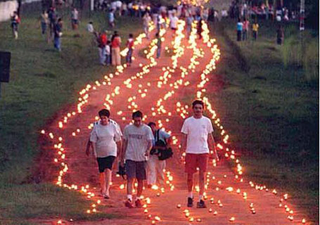
San Ignacio, also known as San Ignacio Guazú, is a city and district in the Misiones Department of Paraguay, located 225 kilometres (140 mi) from Asunción.

Escobar is a town in Escobar District, Paraguarí Department of Paraguay, located some 14 km Paraguarí by Route Villarrica in Paraguarí.

Santiago is a city in Paraguay, located in the Misiones Department. It is one of the most important Jesuit missions in Paraguay.

San Ignacio Miní was one of the many missions founded in 1632, in Argentina, by the Jesuits in what the colonial Spaniards called the Province of Paraguay of the Americas during the Spanish colonial period. It is located near present-day San Ignacio valley, some 60 km north of Posadas, Misiones Province, Argentina. In 1984 it was one of four reducciones in Argentina to be designated by UNESCO as World Heritage Sites.

The Nuestra Señora de Loreto Church in the historic center of Mexico City was the last major church constructed during the colonial period. Constructed between 1806 and 1819, the church tilts significantly to one side due to being constructed of stone of two different weights. Loreto is one of a number of churches in the historic district that the Archdiocese of Mexico says is in imminent danger of being lost due to structural damage from the uneven sinking. In front of the church is a plaza named after the church which used to be the site of Mexico City’s first synagogue.
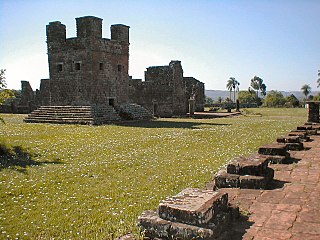
The Jesuit Missions of La Santísima Trinidad de Paraná and Jesús de Tavarangue are located in the Itapúa Department, Paraguay, and are religious mission that are still preserved and that were founded by the Jesuit missioners during the colonization of South America in the 17th century. These religious missions were created in 1609 and developed for 150 years. Both Jesuit missions were declared World Heritage Site by the UNESCO in 1993.

The Historic Centre of Trujillo is the main urban area and the most important center of development and unfolding in the Peruvian city of Trujillo located in La Libertad Region. The whole process of its original urban fabric is in elliptical shape surrounded by España Avenue that was built in the wake of the Wall of Trujillo. It houses the seat of city government and other important entities in the locality. In the center of this historic urban area is the Plaza de Armas of Trujillo that was the scene of the Spanish founded of the city in 1534 and the proclamation of the independence of Trujillo on December 29, 1820.

The San Pedro Macati Church, also known as Saints Peter and Paul Parish Church, is a Roman Catholic Church located in Makati Poblacion, the oldest part of Makati and for that reason, the cultural and heritage barangay of Makati, Philippines. In front of the church facade is Plaza Cristo Rey, which was formerly the San Pedro de Macati Cemetery. The Poblacion Church is a government-recognized cultural property based on the official list provided by the National Historical Commission of the Philippines. After 394 years, the Church was re-dedicated, the first dedication happened in 1620 when it became a parish church, the next after the reconstruction of the facade in 1796 and finally again, on the 30th day of January, 2015. The Dedication was led by Luis Antonio Cardinal Tagle, D.D., Archbishop of Manila, con-celebrated by Rev. Msgr. Gerardo O. Santos, Ed.D, Parish Priest, bishops and priests.

Churches and convents of Old Goa is the name given by UNESCO to a set of religious monuments located in Goa Velha, in the state of Goa, India, which were declared a World Heritage Site in 1986.

